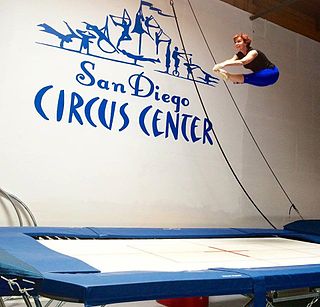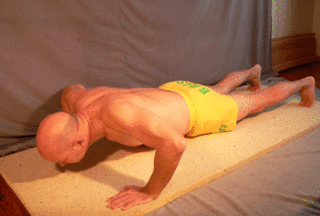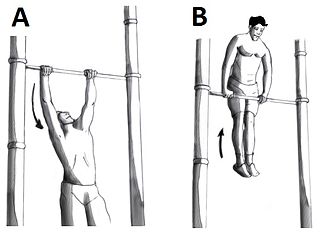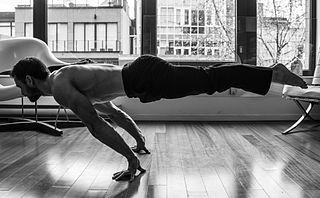
Gymnastics is a type of sport that includes physical exercises requiring balance, strength, flexibility, agility, coordination, artistry and endurance. The movements involved in gymnastics contribute to the development of the arms, legs, shoulders, back, chest, and abdominal muscle groups. Gymnastics evolved from exercises used by the ancient Greeks that included skills for mounting and dismounting a horse, and from circus performance skills.

Calisthenics or callisthenics (/ˌkælɪsˈθɛnɪk/) is a form of strength training that utilizes an individual's body weight as resistance to perform multi-joint, compound movements with little or no equipment.

Trampolining or trampoline gymnastics is a competitive Olympic sport in which athletes perform acrobatics while bouncing on a trampoline. In competition, these can include simple jumps in the straight, pike, tuck, or straddle position to more complex combinations of forward and/or backward somersaults and twists. Scoring is based on the difficulty and on the total seconds spent in the air. Points are deducted for bad form and horizontal displacement from the center of the bed.

A somersault is an acrobatic exercise in which a person's body rotates 360° around a horizontal axis with the feet passing over the head. A somersault can be performed forwards, backwards or sideways and can be executed in the air or on the ground. When performed on the ground, it is typically called a roll.

The push-up is a common calisthenics exercise beginning from the prone position. By raising and lowering the body using the arms, push-ups exercise the pectoral muscles, triceps, and anterior deltoids, with ancillary benefits to the rest of the deltoids, serratus anterior, coracobrachialis and the midsection as a whole. Push-ups are a basic exercise used in civilian athletic training or physical education and commonly in military physical training. They are also a common form of punishment used in the military, school sport, and some martial arts disciplines. Variations of push-ups, such as wide-arm push-ups, diamond push-ups target specific muscle groups and provide further challenges.

A handstand is the act of supporting the body in a stable, inverted vertical position by balancing on the hands. In a basic handstand, the body is held straight with arms and legs fully extended, with hands spaced approximately shoulder-width apart and the legs together. There are many variations of handstands, all of which require the performer to possess adequate balance and upper body strength.
Trampolining terms are used to describe various positions and types of skill performed in the sport of trampolining.

The bridge is an exercise. Many variations of this exercise are employed throughout the world, most commonly the balancing of the body on the hands and the feet. It is intended to improve lower back and gluteus strength. Examples of bridging in sportive or self-defense applications are seen in Kung Fu, Judo, Brazilian jiu jitsu, Capoeira, mixed martial arts, and wrestling.

A handspring is an acrobatic move in which a person executes a complete revolution of the body by lunging headfirst from an upright position into an inverted vertical position and then pushing off from the floor with the hands so as to leap back to an upright position. The direction of body rotation in a handspring may be either forward or backward, and either kind may be performed from a stationary standing position or while in motion.

In weight training, a kettlebell is a cast-iron or cast-steel ball with a handle attached to the top. It is used to perform many types of exercises, including ballistic exercises that combine cardiovascular, strength and flexibility training. Kettlebells are the primary equipment used in the weight-lifting sport of kettlebell lifting.

A back lever is a static hold performed on the rings or the pull-up bar. A back lever is rated as an 'A' value skill on the Code of Points, a scale from A to F, with F being the most difficult.

The following outline is provided as an overview of and topical guide to exercise:

The muscle-up is an intermediate strength training exercise, within the domain of calisthenics. It is a combination routine of a radial pull-up followed by a dip. Variations exist for the rings as well as the bar.

A dip is an upper-body strength exercise. Close grip dips primarily train the triceps, with major synergists being the anterior deltoid, the pectoralis muscles, and the rhomboid muscles of the back. Wide shoulder width dips place additional emphasis on the pectoral muscles, similar in respect to the way a wide grip bench press would focus more on the pectorals and less on the triceps.

The inverted row is an exercise in calisthenics. It primarily works the muscles of the upper back—the trapezius and latissimus dorsi—as well as the biceps as a secondary muscle group. The supine row is normally carried out in three to five sets, but repetitions depend on the type of training a lifter is using to make their required gains. This exercise is lighter on the joints compared to weighted rows. The exercise can also be performed with mixed, underhand, or overhand grips with either wide or narrow hand placement. The exercise is also known under various names such as supine row, bodyweight row, Australian pull up or "horizontal pull-up".
This is a general glossary of the terms used in the sport of gymnastics.

A planche is a skill in gymnastics and calisthenics in which the body is held parallel to the ground, while being supported above the floor by straight arms. It is a move that requires significant strength and balance.
A roll is the most basic and fundamental skill in gymnastics class. There are many variations in the skill. Rolls are similar to flips in the fact that they are a complete rotation of the body, but the rotation of the roll is usually made on the ground while a flip is made in the air with the hips passing over the head and without any hands touching the ground. Rolls also help recover from a fall safely.

Street workouts are a physical activity performed in outdoor parks or public facilities. The movement behind street workouts became popular in Russia, Israel, Myanmar, Morocco, Eastern Europe, and the United States, especially in New York City, Los Angeles, Chicago,Uzbekistan, Philadelphia, Miami, Baltimore, Washington, D.C., and other urban East Coast neighborhoods. It is a combination of athletics, calisthenics, and sports. "Street workout" is a modern name for calisthenics in outdoor parks. There are also street workout teams and organized competitions for exercises such as pull-ups, chin-ups, push-ups, dips, rows, muscle-ups, sit-ups and squats. A street workout also involves static (isometric) holds such as the human flag, front lever, back lever, L-sit and planche.

















